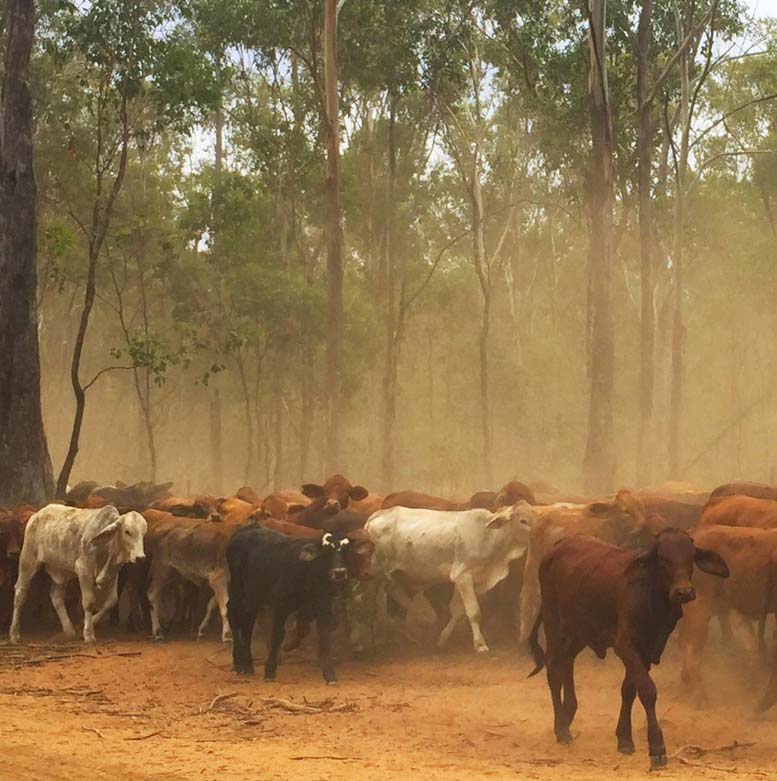Did you know that regulated vegetation (Category B, Category C, Category R) on your property can still be thinned under Queensland’s vegetation management framework?
Thinning vegetation in Category B requires a Development Approval process under the State Development Assessment Provisions, including:
- A Relevant Purposes Application Form under the Vegetation Management Act 1999 (VMA)
- An application fee of $3,373 (as of October 2020)
- Evidence that the vegetation is thickened, including:
- On ground tree counts and
- A comparison site of the same ecosystem that is not thickened
- Responding to performance outcomes under SDAP State code 16: Native vegetation clearing; including
- Wetlands buffers
- Watercourse buffers
- Mechanical thinning on slopes greater than 5%
- Acid sulphate soils
- Maintaining the floristic composition of the vegetation
- Maps of location and extent of the proposed clearing activities
Thinning vegetation in Category C and Category R (regulated regrowth) areas requires notification to NRME including:
- The regional ecosystems that will be thinned
- Maps showing the location of the thinning area
- Records of pre-clearance photographs and GPS coordinates for potential submission to NRME
- Compliance with the Managing regulated regrowth vegetation accepted development vegetation clearing code including:
- Retaining wetlands and riparian protection zones
- Avoiding steep slopes
- Avoiding mature and habitat trees.
Thinning of vegetation can only occur within regional ecosystems listed in the table at the end of this post.
What is possible under the code:
- Clearing native plants that are not normally associated with a vegetation community – like black wattle infestations
- Thinning vegetation to a rate based on the regional ecosystem type of your property (e.g. 200, 300 or 500 trees per hectare)
What is not possible under the code:
- Thinning vegetation by use of a chain
- Thinning for the sole purpose of grazing, thinning needs to be for the purpose of restoring vegetation to its original floristic composition
- Clearing of any mature or habitat trees
DNRME managing regulated regrowth code: https://www.dnrme.qld.gov.au/__data/assets/pdf_file/0009/1446912/managing-regulated-regrowth-code.pdf
DNRME find out what regulated vegetation is mapped on your property: https://www.dnrme.qld.gov.au/qld/environment/land/vegetation/vegetation-map-request-form
Video tutorial for how to measure tree density:
Ecosure can help you through the application processes for thinning, for further details you can call Geoffrey Sinclair or Kade Slater on 07 4994 1000, or email us at admin@ecosure.com.au.
List of regional ecosystems that can be thinned.
| Bioregion | Regional Ecosystems |
| North West Highlands | 1.3.4, 1.5.14, 1.5.2, 1.5.6 |
| Gulf Plains | 2.3.10, 2.3.11, 2.3.15, 2.3.17, 2.3.18, 2.3.19, 2.3.20, 2.3.21, 2.3.22, 2.3.24, 2.3.27, 2.3.29, 2.3.30, 2.3.34, 2.3.36, 2.3.5, 2.3.7, 2.3.9, 2.5.1, 2.5.10, 2.5.12, 2.5.14, 2.5.16, 2.5.2, 2.5.4, 2.5.5, 2.5.9, 2.7.4, 2.7.5, 2.9.4, 2.9.6, 2.10.1, 2.10.2, 2.10.4, 2.10.6, 2.11.1, 2.12.1 |
| Cape York Peninsula | 3.3.16, 3.3.20, 3.3.24, 3.3.28, 3.3.37, 3.3.8, 3.5.24, 3.5.25, 3.5.5, 3.5.6, 3.7.3, 3.9.2, 3.9.4, 3.9.5, 3.9.6, 3.9.7, 3.10.15, 3.11.12, 3.11.13, 3.11.15, 3.11.17, 3.11.7, 3.12.10, 3.12.11, 3.12.18 |
| Mitchell Grass Downs | 4.3.8, 4.3.9, 4.3.10, 4.5.2, 4.5.4, 4.5.8, 4.5.8, 4.5.9, 4.7.4, 4.9.10, 4.9.11, 4.9.12, 4.9.14, 4.9.16, 4.9.18, 4.9.6 |
| Channel Country | 5.5.1, 5.5.2, 5.5.3, 5.5.4, 5.5.6, 5.6.2, 5.6.3, 5.6.4, 5.9.2 |
| Mulga Country | 6.3.16, 6.3.18, 6.3.21, 6.3.22, 6.3.24, 6.3.5, 6.3.7, 6.3.9, 6.5.1, 6.5.10, 6.5.11, 6.5.13, 6.5.14, 6.5.15, 6.5.16, 6.5.17, 6.5.18, 6.5.19, 6.5.2, 6.5.3, 6.5.6, 6.5.7, 6.5.8, 6.5.9, 6.6.1, 6.6.2, 6.7.1, 6.7.10, 6.7.11, 6.7.12, 6.7.13, 6.7.14, 6.7.15, 6.7.16, 6.7.17, 6.7.2, 6.7.6, 6.7.7, 6.7.9, 6.9.2 |
| Wet Tropics | 7.12.28 |
| Central Queensland Coast | 8.5.3, 8.5.5, 8.9.1, 8.11.1, 8.12.12, 8.12.20, 8.12.22, 8.12.6, 8.12.9 |
| Einasleigh Uplands | 9.3.15, 9.3.16, 9.3.19, 9.3.2, 9.3.20, 9.3.21, 9.3.22, 9.3.3, 9.3.5, 9.3.6, 9.3.8, 9.5.10, 9.5.13, 9.5.14, 9.5.3, 9.5.4, 9.5.6, 9.5.7, 9.5.8, 9.5.9, 9.7.1, 9.7.1, 9.7.2, 9.7.3, 9.7.5, 9.8.1, 9.8.11, 9.8.2, 9.8.4, 9.8.9, 9.10.7, 9.11.1, 9.11.13, 9.11.15, 9.11.16, 9.11.17, 9.11.19, 9.11.2, 9.11.22, 9.11.23, 9.11.24, 9.11.25, 9.11.26, 9.11.3, 9.11.31, 9.11.32, 9.11.5, 9.11.7, 9.11.21, 9.12.1, 9.12.10, 9.12.11, 9.12.12, 9.12.13, 9.12.14, 9.12.15, 9.12.16, 9.12.21, 9.12.23, 9.12.24, 9.12.26, 9.12.27, 9.12.28, 9.12.29, 9.12.31, 9.12.32, 9.12.33, 9.12.39, 9.12.4, 9.12.40, 9.12.6, 9.12.7 |
| Desert Uplands | 10.3.10, 10.3.11, 10.3.12, 10.3.14, 10.3.26, 10.3.27, 10.3.28, 10.3.6, 10.3.9, 10.5.12, 10.5.4, 10.5.5, 10.5.9, 10.9.5 |
| Brigalow Belt | 11.3.10, 11.3.12, 11.3.14, 11.3.18, 11.3.19, 11.3.26, 11.3.29, 11.3.30, 11.3.32, 11.3.35, 11.3.36, 11.3.39, 11.3.4, 11.3.6, 11.3.7, 11.3.9, 11.4.2, 11.5.1, 11.5.12, 11.5.13, 11.5.2, 11.5.20, 11.5.21, 11.5.3, 11.5.4, 11.5.5, 11.5.8, 11.5.9, 11.7.4, 11.7.6, 11.7.7, 11.8.4, 11.8.5, 11.9.13, 11.9.2, 11.9.7, 11.10.1, 11.10.11, 11.10.12, 11.10.4, 11.10.6, 11.10.7, 11.10.9, 11.11.1, 11.11.10, 11.11.11, 11.11.12, 11.11.15, 11.11.20, 11.11.4, 11.11.6, 11.11.7, 11.11.9, 11.12.1, 11.12.10, 11.12.11, 11.12.2, 11.12.3, 11.12.5, 11.12.9 |
| South-east Queensland | 12.3.12, 12.8.16, 12.8.17, 12.9-10.2, 12.9-10.4, 12.9-10.7, 12.11.15, 12.12.27, 12.12.4, 12.12.5 |
| New England Tablelands | 13.11.1, 13.11.4, 13.12.2, 13.12.5 |


